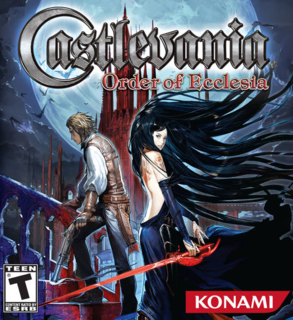Rich landscapes and rewarding gameplay combine to form one of the best Castlevania experiences in years.
Like fine wine, some villains are timeless. They may go down after a hard fought battle, but you know they'll be back, bigger and badder than ever. The Lord of Castlevania makes his return in Order of Ecclesia, and despite some hard fought victories, you'll have a blast.
You play as Shanoa, a member of said order, tasked with nothing less than the complete destruction of Dracula. What makes Shanoa unique is her ability to absorb "glyphs", i.e powers/weapons, found in various levels and dropped by enemies. She can have two active glyphs, as weapons, and can fire them off in rapid succession to create multiple hit combos. These range from simple daggers and swords, to fiery magic spells. Shanoa can also combine these active glyphs to create a more powerful attack, which will drain hearts. Shanoa also has another glyph slot, for passive glyphs. These range from stat boosters to familiars, to increasing the items dropped by enemies, etc. Not too far into the game, you'll come upon an item that lets you switch between three sets of glyphs, so you can effectively set up a range of glyphs to take advantage of enemy weaknesses. It sounds complex, but once in the game, you'll find it fairly unassuming and that the system works quite well.
Like most Castlevania protagonists, Shanoa has a range of stats that increase as she levels up. The glyphs you find in the game can also be leveled up as you acquire more of the same glyphs or find items that will add to the glyphs power.
The controls are fairly commonplace for a Castlevania game, you'll run and jump and smack most enemies around without much trouble. Activating passive glyphs is as simple as hitting the right shoulder button, while dashing backwards to avoid attack requires timely left shoulder button presses.
For the most part, the enemies in the various levels shouldn't pose too much of a problem. The stage bosses, however, can be quite challenging, especially those near the end of the game. This is easily one of the hardest games in the series, not that it should deter you. While the bosses are a challenge, they are far from impossible.
Much has been made of the fact that this is the first handheld Castlevania game to venture into different areas besides the often visited castle itself. The graphics do a wonderful job of conveying the creepy atmosphere of the surrounding lands. From the gold and sapphire rich halls of Ecclesia, to the eerie moonlit forests, to mist laden marshes, to seascapes with rolling waves, it's a visual treat. There is also a rather nice looking town to explore and inhabitants to help with various chores. The town itself harkens back to a time when people could just down pints of ale and pass out instead of worrying about odd creatures roaming the countryside. Those were the days…
The music and sound effects are pretty standard fare, though the music definitely picks up in the final act of the game, adding a sense of urgency, while still keeping to familiar tones and themes.
There isn't a multiplayer mode, per se, but you can link up with friends and browse each others town stores, whose items are dependent on how many quests you've done for your fellow villagers. Its not really a substitute for a real multiplayer mode, however.
With an unlockable hard mode, additional character, and boss rush mode, there's plenty of reason to keep playing after you finish the game, if you're into that sort of thing.
If you yearn to take a vacation, say, somewhere with rich landscapes, like cemetaries at sunset, or abandoned lighthouses filled with danger, and you don't mind the occasional fight for your life against a challenging foe here and there, you may enjoy Castlevania: Order of Ecclesia, and you just might save the world while you're at it.

